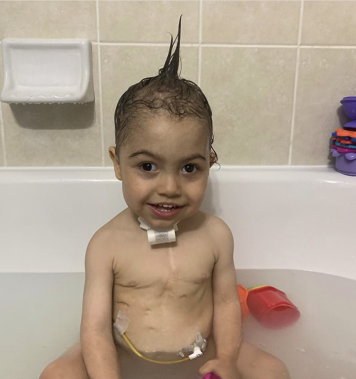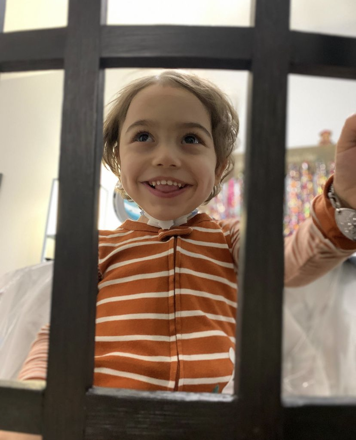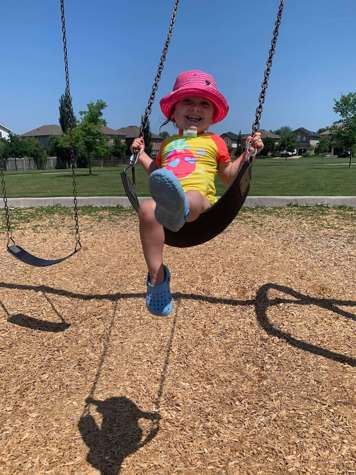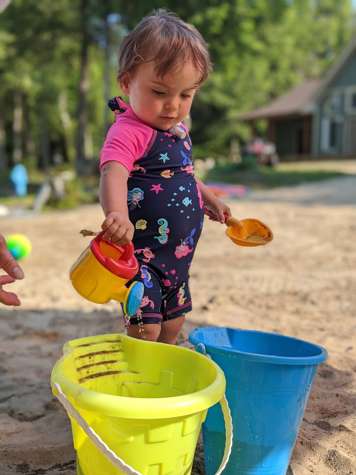At the end of this chapter, you will be able to:
- demonstrate how to safely bathe and dress you child
- discuss the considerations for feeding your child with a tracheostomy
- identify signs of aspiration
- review considerations for feeding when your child requires pulmonary clearance therapy
- describe how to support safe play for your child
- plan your child’s daily schedule
Your child’s daily schedule
There are many steps to caring for your child and many pieces of equipment that also need special care and cleaning. Creating a routine or schedule can help keep track of when things need to be done. Please refer to the chapter on cleaning and replacing equipment and supplies. Below is an example of a schedule of tracheostomy care. Your child’s health-care team can help you create a schedule for your child’s specific needs.
Daily care
- Check tracheostomy ties and change if needed.
- Stoma care and dressing change (twice daily and as needed).
- Suction tracheostomy tube at least every 4 hours.
- Change heat and moisture exchanger (HME).
- Humidifier care for example exchanging water daily (other humidifier cares based on type of humidifier).
- Check oximeter alarm settings and ensure unit is charged.
- Clean reusable inner cannula or replace disposable inner cannula (if applicable).
- Regularly discard suction catheters.
Weekly care
- Change tracheostomy tube.
- Clean humidifier and replace supplies (based on type of humidifier setup).
- Clean suction canister and change suction tubing, Yankauers and tips if used.
- Change oxygen tubing.
Monthly care
- Change humidifier filter.
Protecting your child's airway while bathing

Prepare all tracheostomy emergency equipment and supplies before you give your child a bath:
- suction machine – safely plugged in away from water and fully charged
- emergency tracheostomy kit
- HME or cap (or if child is on a ventilator, then you will continue to keep the ventilator tubing connected)
- stoma gauze in place to soak up any water that gets near the stoma
- manual resuscitation bag with mask
- oxygen (if your child is prescribed it)
- extra inner cannula if your child’s tracheostomy tube has one

To prevent drowning, children with a tracheostomy tube must never immerse their tracheostomy tube under water.
- Always stay with your child when they are near water.
- When bathing your child or washing their hair, it is best to use a bib to prevent water from splashing into the tracheostomy tube but one that is clear/see-through to allow visualization of the tracheostomy tube site.
- If your child has an HME or cap prescribed, use this during bath time.
- Make sure the depth of water is well below your child's waist and avoid too much splashing.
- Use a non-slip bathmat and keep a suction machine close by and working properly.
- For babies, a sponge bath is the safest way to prevent water from entering the tracheostomy tube or stoma.
- Do not apply baby powder to your child’s body as there is a risk of these particles entering their airway.
- Older children can shower by themselves if they take care to avoid any spray going into the tracheostomy. A bib can help.
Precautions
- Water and electricity do not mix. Please ensure the suction machine or ventilator (if your child uses one) are not plugged in near a water source.
How do I wash my child’s hair safely?
Depending on your child’s age, you can wash their hair by:
- laying your child on their back in shallow water
- having your child tip their head over the bathtub and washing their hair using a hand-held shower attachment or with water from a cup
- laying your child on their back on the counter with their head tipped over the sink
How to handle emergencies while bathing your child
If your child’s tracheostomy tube comes out, becomes blocked or water accidently gets into the tracheostomy tube, you need to have a plan to deal with the emergency situation quickly. If you are unable to solve the problem quickly, call 911.
If the tracheostomy tube comes out:
- Remove your child from the water immediately.
- From theemergency tracheostomy kit, insert a clean, tracheostomy tube in the stoma using the obturator. If you cannot insert the same size tracheostomy tube, insert the one size smaller tracheostomy tube and keep it secured in place until emergency help arrives.
- Hold the tube in place with your fingers on the flange.
- Pull out the obturator.
- Secure the ties.
- If your child uses a ventilator, reattach this now.
- If your child is having difficulty breathing, provide support breaths using the manual resuscitation bag. If your child’s condition does not improve, call 911.
If the tracheostomy tube becomes blocked:
- Remove your child from the water immediately.
- Remove the inner cannula, if your child has one, and replace with a clean one.
- Use suctioning to try to remove the blockage.
- If the suction catheter does not go into the tracheostomy tube to the length you normally suction to, remove the ties and proceed with an emergency tracheostomy tube change.
- Remember, at this stage, do not use a manual resuscitation bag on a blocked tracheostomy tube. Air will not get air into your child’s lungs and the situation can be made worse as the mucous plug can be pushed back down into the lungs.
- After the tube change, if a manual resuscitation bag is available and your are trained, use it if necessary.
How to safely dress your child

You don't need to buy special clothing for your child. Any type of clothing is fine as long as the clothing does not block the tracheostomy tube. Avoid:
- turtleneck or polo/mock neck shirts
- plastic bibs
- clothing with loose fibres that may get into the tracheostomy tube and affect your child's breathing
- fuzzy clothing, fuzzy blankets and/or stuffed animals as fibres can get into the tracheostomy
- necklaces or strings as tiny beads can get into the tracheostomy tube and cause blockage
Clothing with button or zipper fronts are easier to put on so that you do not have to place the shirt over the head. If you are placing a shirt over the head, pay close attention to the tracheostomy tube and ensure you stretch the shirt over the tube properly.
Feeding and nutrition

How will the tracheostomy tube affect how my child eats?
A tracheostomy tube can affect your child's ability to safely swallow food and liquid. This is because the tube can:
- weaken the reflexes of and muscles around the larynx (voice box)
- reduce the effectiveness of coughs to clear any food or liquid that enters the trachea
- cause the upper airway to become desensitized to food or liquids (because air is travelling through the tube instead)
How can I tell if my child has difficulty swallowing?
If your child has a swallowing problem:
- they may choke and/or cough while eating or drinking
- they may refuse to eat
- they may have excessive drooling
- their lungs may sound congested
- some food may be found in the tracheostomy secretions
- there may be large amounts of watery secretions from the tracheostomy tube
- they may have frequent respiratory infections
How will my child’s health-care team confirm if my child can feed by mouth?
If it was safe for your child to eat and drink by mouth before the tracheostomy tube was inserted, an occupational therapist or speech language pathologist will examine them to assess if and how a tracheostomy tube insertion has changed this.
The assessment might include:
- observing how your child swallow's different consistencies of liquids and/or solids
- assessing your child's vocal cord movement
- doing a video fluoroscopic feeding study
Using the results of the assessment, your health-care team will work with you and your child to develop a suitable feeding plan. Your child may need a gastrostomy tube (G tube) or a gastrojejunal (GJ tube) to help them get enough nutrients. For more information on tube feeding, please visit: https://www.aboutkidshealth.ca/tubefeeding
Some children have gastroesophageal reflux disease (GERD), which is a long-term, chronic digestive disorder. GERD is when acidic stomach contents reflux (come back up) into the throat and can possibly be aspirated. If you smell formula from the tracheostomy tube, suction up what looks like formula, or you believe your child has aspirated liquids/foods, then you will need to connect with your child’s health-care team as soon as possible.
If my child can eat by mouth, how can I make sure they do so safely with their tracheostomy tube in place?
If your child is able to eat by mouth, suction the tracheostomy tube before they have any food or drink. Suctioning before eating can often prevent the need for suctioning during or after meals, which may cause coughing and could result in vomiting.
It is also important to have your child drink enough liquids during the day to stay hydrated. Hydration will help thin and loosen the secretions, making them easier to clear through coughing and suctioning.
What if my child vomits?
- If your child vomits, turn their head to the side, away from the opening of the tracheostomy tube.
- If you think anything has entered the trach, suction the tracheostomy right away to clear your child’s airway.
- If food or liquid comes through the tracheostomy when they are vomiting, immediately suction the tracheostomy right thoroughly.
- If food has come through the tube, tell the health-care team.
Precautions
- Always observe your child while they are eating to make sure that no food or liquid is entering their tracheostomy tube.
Safe play

How can my child play safely?
Play is encouraged to help with your child’s development and enjoyment of daily life. There are a few precautions to take note of:
- Make sure your child is always supervised.
- If they are a baby or toddler, check that all small toy parts or objects are cleared away in case they are put into the tracheostomy.
- It is not recommended that your child play with dry sand as it may get into the tracheostomy. However, your child can play with wet sand under close supervision. Covering the tracheostomy loosely with an HME or cap will help.
- Avoid toys that shed hair, fur or fuzz as particles can enter the tracheostomy tube.

Can my child go swimming?
It is not safe for your child to swim as there is a high risk of water entering the tracheostomy tube. This increases the risk of infection and even death. Take extra care when your child plays around water, such as at a lake or beach. Remember that your child cannot protect their lungs if water enters the lungs.
Other safety tips
- Your child should not be around anyone who smokes cigarettes, vapes, pipes, or cigars.
- Smoke will irritate your child’s lungs. In public areas, sit in non-smoking sections when possible.
- Your child should not be in direct contact with animals with fine hair. If you have an animal, you will need to dust and sweep more often. Animal hair can float in the air and get into the tracheostomy tube.
- Keep your child away from dust and mold. Try to dust and vacuum often. A home air purifier is also recommended.
Precautions
- Do not use powders, aerosol sprays, perfumes, oil diffusers or cleaning fluids in the same room with your child. Particles and fumes can get into the lungs through the trach. This can cause a burning feeling and breathing problems.